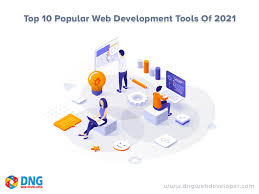Top 10 Essential Tools Every Web Developer Should Know About

Being ahead of the curve is essential for any aspiring developer in the quickly changing area of web development services. Understanding the vast variety of available instruments can be difficult, as new technologies and frameworks appear on a regular basis. However, a few tried-and-true web development tools have survived the test of time and are now a need for any developer’s toolkit.
The proper tools can have a big impact on a developer’s output, effectiveness, and overall development experience. We’ll be looking at ten fundamental tools in this blog post that every developer needs to know. Regardless of expertise level, these tools are a must-have addition to any developer’s toolset because they support both freshers and experienced developers who want to improve the quality of their work. Let’s get going now!
What are Web Development Tools?
Web developers need web development tools, also known as devtools or inspect elements, in order to test and make corrections to their code. Not like integrated development environments (IDEs) and website builders, these technologies aren’t used to make webpages from scratch.
Rather, they support in the assessment and improvement of a website’s or web application’s functionality and design by developers. In short, web development tools ensure a perfect user experience by allowing developers to check that their code is both visually appealing and functionally sound.
Top Ten Essential Web Development Tools Every Developer Should Know
In the rapidly changing world of web development services, maintaining current knowledge of the technology required is important for developers to develop revolutionary, responsive, and effective websites. Ten essential web development tools that every developer should be familiar with are covered in this blog post. This thorough guide will highlight the features, advantages, and functionalities of every tool—from code editors to version control systems, testing frameworks to performance optimization tools—enabling you to increase productivity and build stunning online apps.
1. Chrome Developer Tools
Google Chrome comes with built-in tools for developers to test, debug, and optimize websites right within the browser.
Features of Chrome Developer Tools:
- Console for JavaScript debugging.
- Debugging and profiling tools for developers within the browser.
- Analysis of networks and performance.
- Examine and work with the DOM.
2. Sublime Text
A lightweight, fast text editor that makes it simple to write and edit code.
Features of Sublime Text:
- Platform-neutral (Windows, macOS, Linux).
- Quick and lightweight text editor.
- Vast ecosystem of packages for further functionality.
- Covers a variety of programming languages.
3. GitHub
A platform that lets you collaborate with others, store and distribute your code, and use Git to track changes.
Features of GitHub:
- Pull requests, management of projects, and issue tracking.
- Git-based online platform for version control.
- Server hosting for applications development projects.
- Developer cooperation and code sharing.
4. Atom
An open-source text editor that is ideal for creating and sharing code that is very customizable.
Features of Atom:
- Features that facilitate code sharing with others.
- Text editor that is open-source and created by GitHub.
- Version control through integration with Git.
- Highly flexible and integrated with a package manager.
5. CodePen
An online playground that makes it simple for displaying your work by allowing you to create and share front-end code snippets.
Features of CodePen:
- HTML, CSS, and JavaScript are supported.
- Front-end developer code editor available online.
- Teams working together in real time.
- A social network for code snippet sharing and discovery.
6. Sass
A program that adds features like variables and reusable styles to CSS to increase its efficiency.
Features of Sass:
- Use functions and mixins to create reusable code.
- Compilation into a common CSS file.
- Preprocessor for CSS that introduces capabilities like variables and nested rules to the standard CSS.
- Stylesheets that are maintainable and modular.
7. Bootstrap
A fundamental framework that makes it easier to develop visually appealing and responsive websites.
Features of Bootstrap:
- Design grid for layout.
- Front-end framework for creating websites that are mobile-first and responsive.
- Sass variables allow for easy modification.
- Templates and pre-designed elements.
8. Grunt
A work runner that saves you time and effort by automating repetitive operations in your development workflow.
Features of Grunt:
- Plugins for a range of applications, including testing, compilation, and minification.
- Automate repetitive processes in the development workflow with a task runner.
- Configuration using a straightforward JavaScript file.
9. jQuery
DOM manipulation and AJAX requests are made easier with the help of this lightweight and speedy library for JavaScript scripts.
Features of jQuery:
- Support for Ajax for simple data loading.
- JavaScript library that is lightweight and fast.
- Compatibility across browsers.
- Improves event management and DOM manipulation.
10. Visual Studio Code
With many features and support for multiple programming languages, this free code editor has IntelliSense and other useful features.
Features of Visual Studio Code:
- Extensible and having a large library of add-ons.
- Microsoft’s code editor, available for free and open source.
- Git version control integrated in.
- IntelliSense provides recommendations and code completion.
How Can Tools for Web Development Improve Your Workflow?
It goes without saying that web development tools can simplify your life. It’s not always readily evident what these technologies can accomplish or how they could improve your workflow. Web development tools can improve your workflow in a number of ways, including:
- Simplifying the process of development: Web development tools ensure an effortless and effective workflow that saves you time and money by helping manage every part of a web project, from planning to launch.
- Encouraging the identification and correction of errors: Debugging and error-handling capabilities are frequently integrated into web development tools, which facilitates the identification and resolution of problems.
- Increasing productivity: Web development tools facilitate efficient workflow and a more productive coding team by saving time and effort.
- Collaboration is improved: With the use of these tools, team members, clients, and stakeholders can communicate and work together more effectively, which results in more successful projects.
- Maintaining consistency: A web project’s overall experience is improved when all aspects are consistent because to a well-defined web development workflow.
Wrapping Up
Web developers can create beautiful websites, optimize their workflows, and maintain their competitive advantage in a constantly changing market by becoming proficient with these fundamental tools. In the fast-paced field of web development, having the appropriate tools at your service is important for success, whether you’re working alone or in a team.





